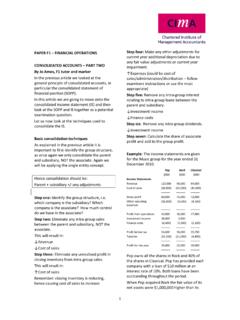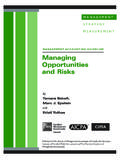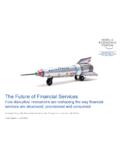Transcription of 2013 Salary Guide - CIMA
1 Your business and recruitment handbook2013 Salary Guide03 From the Managing Director04 Using the 2013 Salary Guide05 Key trends in financial services recruitment14 finance and accounting salaries 16 Banking operations salaries18 insurance salaries20 Technology salaries23 Remuneration trends24 Working with Robert Half Financial ServicesMore than a million people across the UK work in financial services, which represents nearly 4% of total UK employment. Having up-to-date remuneration data specific to the industry can help organisations determine competitive Salary levels, which allows them to recruit and retain the market s top talent. In an unpredictable climate, where local and global markets continue to be affected by the eurozone and Middle East crises, it is more vital than ever to secure the right talent to leverage growth. At a time of great change for the industry, highly skilled middle- and back-office professionals have a greater role to play.
2 Demands from investors and regulators have resulted in the need for more stringent corporate governance, bringing regulatory change. With local and international bodies each endorsing varied and complex regulations, multinational organisations in particular are finding that complying has become more challenging. Compliance budgets are stretched thin, so securing the requisite talent to help navigate an ever-changing environment will be a challenge facing hiring managers for the foreseeable future. However, according to our research, business growth may be on the horizon. Business outlook has improved, with most financial services executives indicating they are somewhat or very confident in their companies growth prospects compared with last year. finance professionals, in particular, are benefitting from this optimism as companies look for additional insight and strategy into business process improvement, cost savings and new sources of revenue.
3 It is, therefore, vital that companies identify and obtain the expertise they need as they seek business prosperity. Monitoring Salary trends can be a challenge. I hope you find our 2013 Salary Guide useful, and I welcome you to contact one of our financial services recruitment consultants specialising in finance , accounting, banking operations, insurance or technology to discuss trends affecting your organisation. From the Managing DirectorPhil SheridanManaging Director United KingdomRobert Half UKRobert Half Financial Services 2013 Salary Guide03 Using the 2013 Salary GuideThe 2013 Salary Guide offers starting salaries for banking and capital markets professionals across finance , banking operations, insurance and technology. This resource can help you determine Salary levels for new employees, plan budgets and navigate today s hiring environment. The Salary ranges represent starting salaries only because factors such as seniority and policies regarding pay reviews vary by company.
4 Bonuses and other forms of remuneration, such as benefits and pension schemes, are also not taken into account. We ve also surveyed executives within the financial services industry on their remuneration plans for existing employees; we ve highlighted this on page 23. The most authoritative resourceWe collect information from various sources, including:> Temporary, interim and permanent placements made through Robert Half Financial Services> Insight from our senior recruitment managers> Exclusive research we conduct among UK senior executives> Information from the Office for National Statistics and HM Revenue & Customs> Our comprehensive analysis of current and future hiring trendsRobert Half Financial Services 2013 Salary Guide4 With the financial services industry continuing to transform and reinvent itself, many firms are focused on profitability.
5 They are moving away from business and product lines where the cost of capital is too high, shrinking their balance sheets to improve their capital efficiency and changing their risk-weighted asset , the ever-evolving regulatory environment puts additional strain on the industry as companies try to maximise profitability while remaining compliant. This dual and often competing focus has raised the bar for the industry, and securing the right talent to address these issues efficiently and effectively is more important than ever. Hiring within the industry has largely mirrored these trends. Where headcount reductions have occurred in less profitable areas, some roles have been absorbed into other units, and demand for skilled professionals within the sector continues to outweigh supply in some areas. While hiring has not returned to pre-recession levels, talent gaps exist and signal a warning for what may be a more significant challenge in the future, particularly in regulation, risk and compliance.
6 Organisations are therefore reviewing their succession-planning strategies and taking a more holistic approach to recruitment and retention. Despite market uncertainty, many financial services executives have learned from mistakes and are confident about organisational growth in the forthcoming year. Hiring is cautious, often resulting in multiple interview rounds for both permanent and temporary candidates and more senior-level sign-offs required before an offer is extended. With some profiles in short supply, many organisations realise that their top choices are accepting offers from competing organisations. Much of the hiring revolves around business-critical roles, with a mix of mid- and senior-level talent as well as newly qualified accountants seeing the greatest opportunity. Companies under pressure to do more with less expect employees to be both specialists and generalists, demonstrating high-level experience and knowledge across multiple areas.
7 There is growing concern around staff retention, with two in three executives concerned about losing top performers to other opportunities in the coming year. Key trends in financial services recruitmentof UK executives are concerned about losing top performers to other opportunities in the coming year67% Robert Half Financial Services 2013 Salary Guide05 Regulatory environmentNot surprisingly, regulatory change remains top of mind for the industry as organisations not only navigate evolving requirements but are also challenged to find staff with relevant experience in such unchartered territory. More than eight in 10 executives surveyed have found regulatory change challenging and report that only one in 10 staff is very knowledgeable on the subject. More worrying is that executives feel that nearly four in 10 of their employees are not knowledgeable. As a result, executives are spending nearly one full day a week managing regulatory reporting and change, with most saying this is more or significantly more than three years ago.
8 There remains a significant need for risk, regulatory and compliance professionals, and as demand outweighs supply, companies face increased budgetary pressure to secure the market s most sought-after individuals. As a result, many organisations are turning to interim and project professionals as a cost-effective solution to access in-demand skills and waves of regulation within the banking sector will drive demand for risk, regulatory and compliance professionals yet also create the dual effect of creating an uncertain climate where workers are becoming more anxious about moving jobs. As uncertainty prevails, more financial services professionals are looking to the relative security that tenure affords. This has further contributed to the talent shortage organisations compliance budgets have increased compared to pre-2008 53% Robert Half Financial Services 2013 Salary Guide06 Anti-Money Laundering (AML) requirements.
9 Disclosure or reporting requirements ..Privacy requirements ..Anti-corruption III ..Sanction requirements ..IFRS ..FATC A ..Solvency II ..Turner Report/FSA ..SOX, JSOX or equivalent ..Dodd-Frank Act ..MiFID II ..35%33%32% 22%17%13% 11%8%42%7%5% 3%2%Which three of the following global regulations have had the most significant effect on your business? Temporary/interim headcount: 32% Permanent headcount: 30% Technology: 14% External auditors: 12% None: 12%As part of your compliance budget, which area has received the largest percentage increase?Source: Robert Half survey of 100 financial services CFOs/COOsRobert Half Financial Services 2013 Salary Guide07 finance & accounting finance and accounting recruitment has trended upwards, although new job creation has largely centred on regulatory, financial control and financial business partnering. Hiring within other functional areas has been primarily to fill vacated positions, although companies are willing to make additional hires to support revenue-generating activities.
10 Business partnering, while once conceptual, has evolved into its own functional role, with finance professionals working within IT, business development and HR to ensure that processes are efficient and economical. Not surprisingly, more than a third of financial services CFOs indicate that identifying and implementing business strategy is of greatest importance to their finance function. Key trends by specialismSkills in demand:> Exposure to technical accounting standards> Financial Systems: SAP, Oracle, Hyperion Financial Management, SUN, TM1> Change management> Commercial and business acumenPositions in demand:> Financial business partners> Fund accountants> Financial analysts> Internal auditors> Systems implementation specialists>Robert Half Financial Services 2013 Salary Guide08 Banking operations Regulatory change has also affected middle-office roles, with institutions focused on completing transactions that are compliant, accurate and organisations shifting their services into the most profitable product lines, hiring demand has followed suit with the strongest demand in trade support and fund administration.



















